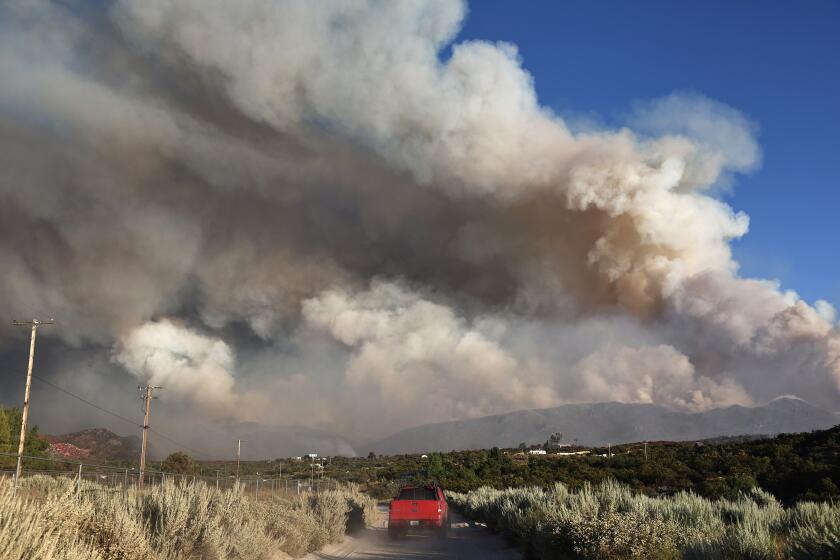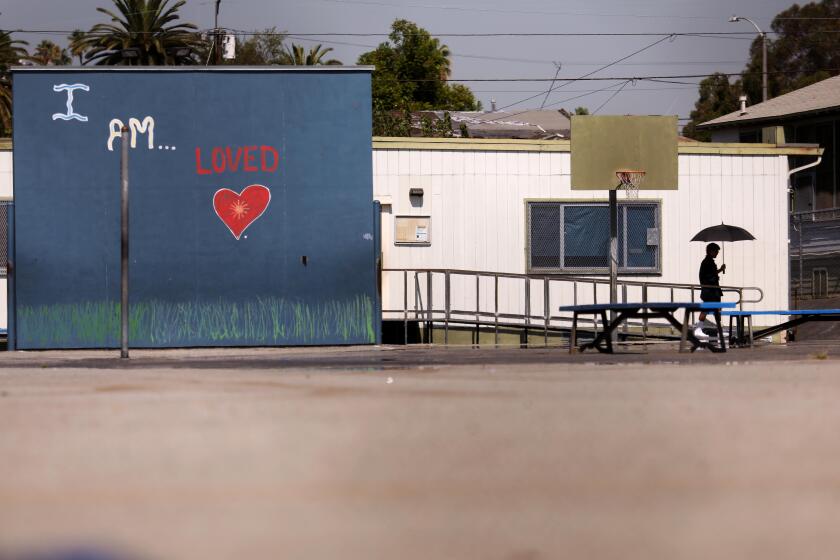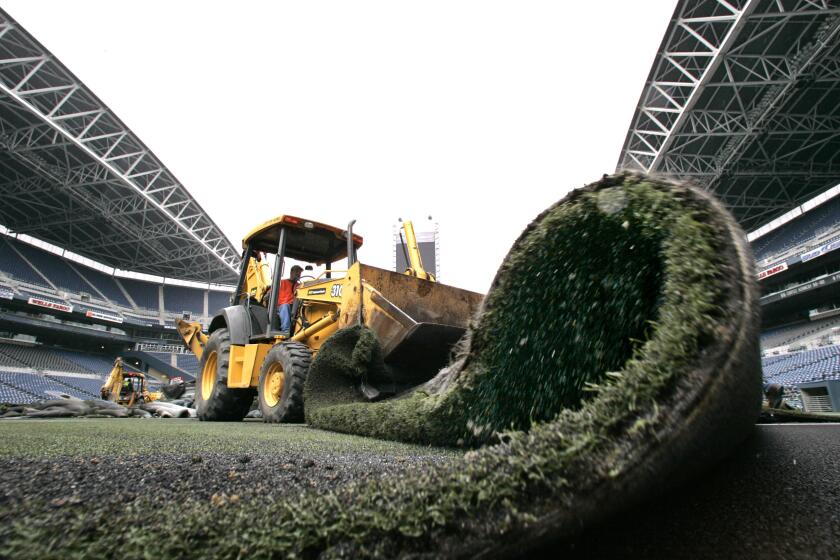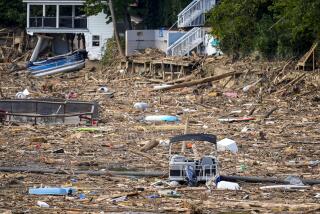I’m a pediatrician, and I know how climate change threatens children

- Share via
A few years ago, while visiting Hiroshima, Japan, I attended a talk by a well-known peace activist and hibakusha — an atomic bomb survivor. Keiko Ogura had been 8 years old on Aug. 6, 1945, living with her family only a mile and a half from ground zero, in a house shielded behind a small hill. She recounted searing memories that had shaped the rest of her life. When I spoke with her afterward, she told me that, while it was important for all survivors to warn others about what they’d seen, the testimonies of those who had been children that day were especially important. “Without showing what happened to a child,” she said, “the world cannot understand.”
I am a pediatrician in Reno, the fastest-warming city in the U.S. I am haunted by Keiko Ogura’s words as I look into the eyes of the babies and children in my clinic. A slow-motion bomb is going off over their heads, and unless parents understand the urgent policy choice they face this November, these children will carry the agony and sorrow of our decisions long after we are gone.
Jokes aside, it’s not too late to start getting the climate crisis under control.
The “bomb,” in this case, is the billions of tons of carbon pollution that have been spewed into Earth’s atmosphere through the burning of fossil fuels. It now forms a heat-trapping blanket over the planet, and the harms are everywhere to see. Last month, Reno’s neighborhoods fell silent as a severe heat wave brought a string of above-100-degree days — once unheard of here — and forced children indoors, robbing them of normal summer activities. We know what can follow that kind of heat and kept a wary eye to our west, waiting for smoke from the next megafire to begin pouring over the Sierra Nevada. It soon arrived: haze from California’s Park fire and Crozier fire is now polluting our air.
We are hardly alone. Tens of millions of Americans — from already hot places like Miami and Las Vegas to usually cool cities like Missoula, Mont., and Portland, Ore. — have baked in extreme heat this summer, with many cities breaking temperature records. Hurricane Beryl, the earliest Category 5 and Category 4 storm in history, battered Texas, and Tropical Storm Debby drenched the East Coast with climate-change intensified precipitation.
Beyond the headlines there are thousands of untold stories of children who are being hurt. Because of their different physiology, small size, dependence on adults and still-developing organs, the youngest among us are uniquely vulnerable to the health threats posed by a warming world — by heat waves, wildfires, hurricanes, infectious diseases, air pollution and more. Unlike a literal bomb, however, climate change injures children in insidious and indirect ways, and parents may not even realize that they’ve been harmed.
Monday is the first day of class for students at L.A. Unified and other schools around California. Too many kids face hot classrooms that lack adequate cooling.
Take, for example, the wildfire smoke that now regularly engulfs my city. The smoke is packed with fine and ultrafine particles — microscopic soot and droplets bound to heavy metals and toxic chemicals — that are also found in fossil fuel emissions such as car exhaust. We know that children who are chronically exposed to particle pollution will tend to have smaller, stiffer lungs; moving to an area with clean air before they’re done growing can increase their lung capacity 10-12%. And we know that the tiniest particles don’t stop at the lungs: They’ve been found encased in Alzheimer’s-like plaques in the brains of children living in heavily polluted neighborhoods, and chronic exposure (including prenatally) increases the odds of autism, ADHD and cognitive and behavioral problems.
Parents know if their child tires easily on the playground or is struggling in school. But because the effects of climate change on children are neither immediately obvious nor easy to prove in any single child, fossil fuels usually escape blame. After a 4-month-old baby and 10-year-old boy in Arizona died from heatstroke on family outings in July, many were quick to criticize the parents. Few focused their ire on the fossil fuel industry, which made the temperatures that killed both children far more likely.
Even on vacation in rural Northern California, it’s hard to escape.
Extreme heat especially affects children in low-income families or in cities that haven’t needed air conditioning in the past. A 2022 review of data from 47 children’s hospitals across the country found that pediatric emergency room visits jumped 17% in hot weather. Domestic violence, child abuse and child neglect also increase as high heat lowers parents’ ability to cope. Children struggle to learn in school. The risk of babies dying in hot cars, or athletes collapsing on the field, rises. And air pollution and heat have profoundly negative effects on pregnant women, fetuses and newborns, increasing life-threatening pregnancy complications, preterm birth, infant mortality, childhood cancers and more.
And today’s children face another, more profound threat. Like Ms. Ogura, they may one day have to survive in a world that none of us would recognize. On our current trajectory, the U.N. calculates that Earth will warm nearly 3 degrees Celsius over preindustrial temperatures by 2100; within decades, our children and grandchildren could see widespread ecosystem and civilization collapse.
Los Angeles should help lead California and the country in banning plastic ground covering. It’s expensive, unhealthy and terrible for the environment.
It doesn’t have to be this way. The Intergovernmental Panel on Climate Change has shown that if we cut global emissions of carbon dioxide in half this decade, we could still keep the trend line of Earth’s warming at or near 1.5 degrees Celsius. The Biden administration’s 2022 Inflation Reduction Act, aided by the rapidly dropping price of solar energy and batteries, has ignited a green energy and manufacturing revolution in the U.S. and raised hopes that we will meet those goals.
Yet Project 2025, the controversial blueprint for a second Trump term, calls for a dismantling of our clean energy progress.
Over the years I have witnessed the fierce protectiveness of parents countless times. But they can’t protect their children from climate change unless they grasp the urgency of this moment. If we squander the very narrow window of time to prevent the worst, and drive emissions up instead of down, the consequences will be devastating.
On that terrible day nearly 80 years ago, Keiko Ogura survived because her father, worried after hearing air raid sirens the night before, kept her home from school. American parents now face a similar moment. Escalating heat waves, wildfires and hurricanes are our sirens. We must look at what’s happening to our children and protect them.
Debra Hendrickson is a pediatrician and a clinical professor at the University of Nevada School of Medicine. She is the author of “The Air They Breathe: A Pediatrician on the Front Lines of Climate Change.”
More to Read
A cure for the common opinion
Get thought-provoking perspectives with our weekly newsletter.
You may occasionally receive promotional content from the Los Angeles Times.










